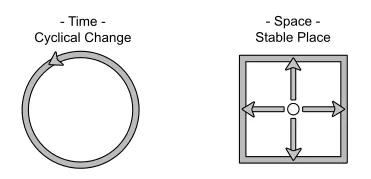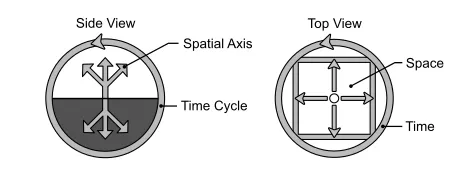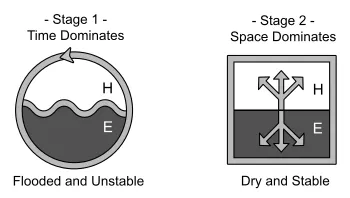God called the light ‘day’ and the darkness ‘night.’
The archaic concepts of time and space are very different from their modern counterparts, which are completely detached from the natural human point of view. Therefore, we must look at the universe from a long forgotten perspective to rediscover these patterns.
To rediscover this perspective, it will be useful to discuss three fundamental differences between ancient and modern notions of time:
- It is important to recognize that the archaic concept of time was associated with the cosmic cause of change.
- ‘Time’ does not refer to any change whatsoever, but to cyclical transformation. This paradoxical force is what transforms summer into winter, top into bottom, first into last, life into death, and vice-versa.
- The most important difference between archaic and modern notions of time is that ‘time’ may be considered the opposite of ‘space’ in ancient cosmology. Of course, in this context, space is defined as a stabilizing power against the transformative forces of time.
The universe resembles the following picture from a spiritual perspective. It contains a relatively stable place (space) surrounded by a relatively unstable periphery (time) where ironic and unexpected events tend to occur. Two forces are constantly pushing against each other in this universe: the transformative forces of time and the stabilizing forces of space
Flooded Land vs. Dry Land
He restrains the waters, and they dry out [space]; he unleashes them, and they overturn the earth [time]
As mentioned, time and space should be interpreted as opposites in biblical cosmology. They should also be associated with two fundamental stages of creation:
- a primitive flooded world on the first day of creation
- the construction of a dry world on the second and third days
According to this cosmology, the dominion of ‘time’ corresponds to a more primitive stage of creation where everything was fluid and continuously transforming into its opposite: up into down, down into up, like the oscillating waves of an ocean. This comes in contrast with the dominion of ‘space,’ which is an artificial stage that stabilizes reality by holding these opposites apart.
Symbol Embodies Water Change (Time) Tree Space Mountain Space In ancient cosmology, space and time are engaged in a constant battle over manifestation. 2 The cycle or wave swallows space and overturns the earth, while the spatial axis splits the waters and founds the earth. In general, there is a constant tug-of-war between the dominion of cyclical time and the dominion of spatial stability.
Footnotes
-
Pageau, Matthieu (May 29, 2018). The Language of Creation: Cosmic Symbolism in Genesis: A Commentary (“LoC”). Ch 31. ↩
-
Pageau. LoC. Ch 32. ↩


